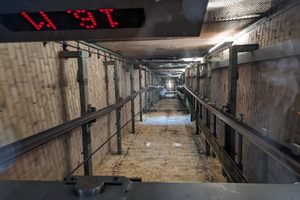Kuppelaufzug in Hannover, Germany
Opened in 1913, Hanover's Neues Rathaus (New Town Hall) has a stately dome befitting a palace. In order to provide convenient access to the observation deck 100 meters above the ground, the dome comes with an elevator. To avoid obstructing the grand inside of the dome, engineers opted for a particularly novel design. The Kuppelaufzug ("Dome Elevator") follows the side of the dome on an irregular, roughly parabolic path. Although there are other diagonal elevators, such as at the Eiffel Tower, none of these follow a curved route. Likewise, other "curved elevators" do not use traditional cables and railings alone, rather being assisted by racks, for instance at the Gateway Arch. Also unlike the Gateway Arch, this elevator does not keep itself level. Instead, it tilts to the side with its passengers as it ascends. At some points along the shaft, the elevator has as little as under five millimeters of clearance from the wall. Although it has five stops, only the top and bottom ones are usually open to the public. Remarkably, the original elevators, which was installed in 1908, accomplished all this with wooden rails. In 2008, it was replaced by a more modern iteration with tube rails from the Hanoverian company Lutz. The reconstruction proved trickier than expected. The elevator car bumped into the shaft multiple times during construction—once with the Mayor of Hanover inside. Eventually, they worked out the kinks, while adding a few extra features in the process. Thanks to a wireless connection using coded radio, the elevator can safely transport passengers to the bottom even in the machine room loses power. Best of all, the elevator car has a floor that can become transparent, offering passengers a view of the inside of the dome as they zoom upward.


Opened in 1913, Hanover's Neues Rathaus (New Town Hall) has a stately dome befitting a palace. In order to provide convenient access to the observation deck 100 meters above the ground, the dome comes with an elevator. To avoid obstructing the grand inside of the dome, engineers opted for a particularly novel design. The Kuppelaufzug ("Dome Elevator") follows the side of the dome on an irregular, roughly parabolic path.
Although there are other diagonal elevators, such as at the Eiffel Tower, none of these follow a curved route. Likewise, other "curved elevators" do not use traditional cables and railings alone, rather being assisted by racks, for instance at the Gateway Arch. Also unlike the Gateway Arch, this elevator does not keep itself level. Instead, it tilts to the side with its passengers as it ascends.
At some points along the shaft, the elevator has as little as under five millimeters of clearance from the wall. Although it has five stops, only the top and bottom ones are usually open to the public. Remarkably, the original elevators, which was installed in 1908, accomplished all this with wooden rails.
In 2008, it was replaced by a more modern iteration with tube rails from the Hanoverian company Lutz. The reconstruction proved trickier than expected. The elevator car bumped into the shaft multiple times during construction—once with the Mayor of Hanover inside.
Eventually, they worked out the kinks, while adding a few extra features in the process. Thanks to a wireless connection using coded radio, the elevator can safely transport passengers to the bottom even in the machine room loses power. Best of all, the elevator car has a floor that can become transparent, offering passengers a view of the inside of the dome as they zoom upward.


































































-Baldur’s-Gate-3-The-Final-Patch---An-Animated-Short-00-03-43.png?width=1920&height=1920&fit=bounds&quality=70&format=jpg&auto=webp#)






























































































































































































